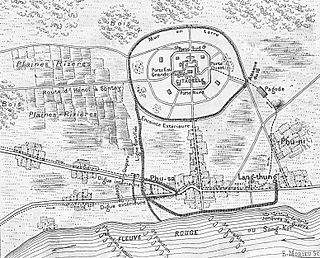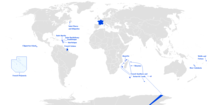
The Black Flag Army was a splinter remnant of a bandit group recruited largely from soldiers of ethnic Zhuang background, who crossed the border in 1865 from Guangxi, China into Upper Tonkin, then part of the Empire of Annam. Although brigands, they were known mainly for their fights against the invading French forces, who were then moving into Tonkin. With the sanction of both Vietnamese and Chinese authorities, the Black Flags joined the Vietnamese regular forces, stemming French encroachment beyond the Red River Delta. The Black Flag Army is so named because of the preference of its commander, Liu Yongfu, for using black command flags. The army was officially disbanded in 1885 as a result of the Treaty of Tientsin between the French and the Qing. However, remnants of the army continued to wage a guerilla war against French colonial authorities for years.

The Battle of Bang Bo, known in China as the battle of Zhennan Pass (Chinese:鎮南關之役), was a major Chinese victory during the Sino-French War. The battle, fought on 23 and 24 March 1885 on the Tonkin-Guangxi border, saw the defeat of 1,500 soldiers of General François de Négrier's 2nd Brigade of the Tonkin Expeditionary Corps by a Chinese army under the command of the Guangxi military commissioner Pan Dingxin (潘鼎新).

The Battle of Phu Lam Tao was a politically significant engagement during the Sino-French War, in which a French Zouave battalion was defeated by a mixed force of Chinese soldiers and Black Flags.

The Sơn Tây Campaign was a campaign fought by the French to capture the strategically important city of Sơn Tây in Tonkin from Liu Yongfu's Black Flag Army and allied contingents of Vietnamese and Chinese troops. The campaign was one of several clashes between the Tonkin Expeditionary Corps and the Black Flag Army during the Tonkin Campaign (1883–1886), and took place during the period of undeclared hostilities that preceded the Sino-French War.

The Battle of Hòa Mộc was the most fiercely fought action of the Sino-French War. At heavy cost, Colonel Giovanninelli's 1st Brigade of the Tonkin Expeditionary Corps defeated forces of the Black Flag and Yunnan Armies blocking the way to the besieged French post of Tuyên Quang.

The Lạng Sơn Campaign was a major French offensive in Tonkin during the Sino-French War. The Tonkin Expeditionary Corps, under the command of General Louis Brière de l'Isle, defeated the Chinese Guangxi Army and captured the strategically important town of Lạng Sơn in a ten-day campaign mounted under formidable logistical constraints.

The Bắc Ninh Campaign was one of a series of clashes between French and Chinese forces in northern Vietnam during the Tonkin campaign (1883–86). The campaign, fought during the period of undeclared hostilities that preceded the Sino-French War, resulted in the French capture of Bắc Ninh and the complete defeat of China's Guangxi Army.

François Oscar de Négrier was one of the most charismatic French generals of the Third Republic, winning fame in Algeria in the Sud-Oranais campaign (1881) and in Tonkin during the Sino-French War.

The Tonkin Campaign was an armed conflict fought between June 1883 and April 1886 by the French against, variously, the Vietnamese, Liu Yongfu's Black Flag Army and the Chinese Guangxi and Yunnan armies to occupy Tonkin and entrench a French protectorate there. The campaign, complicated in August 1884 by the outbreak of the Sino-French War and in July 1885 by the Cần Vương nationalist uprising in Annam, which required the diversion of large numbers of French troops, was conducted by the Tonkin Expeditionary Corps, supported by the gunboats of the Tonkin Flotilla. The campaign officially ended in April 1886, when the expeditionary corps was reduced in size to a division of occupation, but Tonkin was not effectively pacified until 1896.
The Retreat from Lạng Sơn was a controversial French strategic withdrawal in Tonkin at the end of March 1885 that brought down the government of the French premier Jules Ferry and brought the Sino-French War to an end in circumstances of considerable embarrassment for France.

The Battle of Nui Bop was a French victory during the Sino-French War. The battle was fought to clear Chinese forces away from the French forward base at Chu, and was an essential preliminary to the Lạng Sơn Campaign in February 1885.

The Battle of Đồng Đăng was an important French victory during the Sino-French War. It is named after the town of Đồng Đăng, then in northern Tonkin, close to the border between China and Vietnam.

The Capture of Hưng Hóa was an important French victory in the Tonkin Campaign (1883–86).

Charles-Théodore Millot was a French general who distinguished himself in the Franco-Prussian War (1870–71) and the Tonkin Campaign (1883–86). His victories at Bắc Ninh and Hưng Hóa brought to an end the two-year undeclared war in northern Vietnam between France and China, and paved the way for the conclusion of the Tientsin Accord between the two countries on 11 May 1884. Millot resigned as general-in-chief of the Tonkin Expeditionary Corps shortly after the outbreak of the Sino-French War on 23 August 1884 and returned to France.

The Tonkin Expedition commemorative medal was awarded to all the French soldiers and sailors who took part in the battles of the Tonkin campaign and the Sino-French War between 1883 and 1885. The medal, decreed by a law of 6 September 1885, was minted at the Monnaie de Paris and distributed shortly before the Bastille Day parade on 14 July 1886 to around 65,000 soldiers and sailors. The medal was later awarded to participants in a number of earlier and later campaigns in Indochina, bringing the total number of recipients to 97,300.
The Tonkinese Rifles were a corps of Tonkinese light infantrymen raised in 1884 to support the operations of the Tonkin Expeditionary Corps. Led by French officers seconded from the marine infantry, Tonkinese riflemen fought in several engagements against the Chinese during the Sino-French War and took part in expeditions against Vietnamese insurgents during the subsequent French Pacification of Tonkin. The French also organized similar units of indigenous riflemen from Annam and Cambodia. All three categories of indigenous soldiers were known in Vietnam as Lính tập,





















